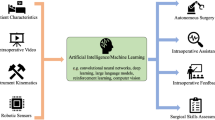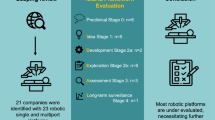Abstract
Background
This study aimed to define perceptions of the need and the value of new simulation devices for laparoscopic and robot-assisted surgery. The initial experience of surgeons using both robotic and nonrobotic laparoscopic simulators to perform an advanced laparoscopic skill was evaluated.
Methods
At the 2006 Society of American Gastroesophageal Surgeons (SAGES) meeting, 63 Learning Center attendees used a new virtual reality robotic surgery simulator (SEP Robot) and either a computer-enhanced laparoscopic simulator (ProMIS) or a virtual reality simulator (SurgicalSIM). Demographic and training data were collected by an intake survey. Subjects then were assessed during one iteration of laparoscopic suturing and knot-tying on the SEP Robot and either the ProMIS or the SurgicalSIM. A posttask survey determined users’ impressions of task realism, interface quality, and educational value. Performance data were collected and comparisons made between user-defined groups, different simulation platforms, and posttask survey responses.
Results
The task completion rate was significantly greater for experts than for nonexperts on the virtual reality platforms (SurgicalSIM: 100% vs 36%; SEP Robot: 93% vs 63%; p < 0.05). Prior robot use was predictive of task completion on the SEP Robot, and nonexperts were more likely to complete the virtual reality task on the SEP Robot than on the SurgicalSIM. Experts performed better than nonexperts for all performance measures on the ProMIS. All the survey scores pertaining to realism except image quality were higher for the ProMIS than for either virtual reality trainer.
Conclusion
The task completion rate was the best discriminant of expert performance on both virtual reality platforms, whereas simulator metrics best discriminated expertise for the videoscopic platform. Similar comparisons for the virtual reality platforms were not feasible because of the low task completion rate for nonexperts. The added degrees of freedom associated with the robotic surgical simulator instruments facilitated completion of the task by nonexperts. All platforms were perceived as effective training tools.


Similar content being viewed by others
References
Seymour NE, Gallagher AG, Roman SA, O’Brien MK, Bansal VK, Andersen DK, Satava RM (2002) Virtual reality training improves operating room performance: results of a randomized, double-blinded study. Ann Surg 236:458–464
Grantcharov TP, Kristiansen VB, Bendix J, Bardram L, Rosenberg J, Funch-Jensen P (2004) Randomized clinical trial of virtual reality simulation for laparoscopic skills training. Br J Surg 91:146–150
Hyltander A, Liljegren E, Rhodin PH, Lonroth H (2002) The transfer of basic skills learned in a laparoscopic simulator to the operating room. Surg Endosc 16:1324–1328
Lee EC, Rafiq A, Merrell R, Ackerman R, Dennerlein JT (2005) Ergonomics and human factors in endoscopic surgery: a comparison of manual vs telerobotic simulation systems. Surg Endosc 19:1064–1070
Moorthy K, Munz Y, Dosis A, Hernandez J, Martin S, Bello F, Rockall T, Darzi A (2004) Dexterity enhancement with robotic surgery. Surg Endosc 18:790–795
Halvorsen FH, Elle OJ, Dalinin VV, Mork BE, Sorhus V, Rotnes JS, Fosse E (2006) Virtual reality simulator training equals mechanical robotic training in improving robot-assisted basic suturing skills. Surg Endosc 20:1565–1569
Broe D, Ridgway PF, Johnson S, Tierney S, Conlon KC (2006) Construct validation of a novel hybrid surgical simulator. Surg Endosc 20:900–904
Author information
Authors and Affiliations
Corresponding author
Rights and permissions
About this article
Cite this article
Lin, D.W., Romanelli, J.R., Kuhn, J.N. et al. Computer-based laparoscopic and robotic surgical simulators: performance characteristics and perceptions of new users. Surg Endosc 23, 209–214 (2009). https://doi.org/10.1007/s00464-008-9805-3
Received:
Revised:
Accepted:
Published:
Issue Date:
DOI: https://doi.org/10.1007/s00464-008-9805-3




